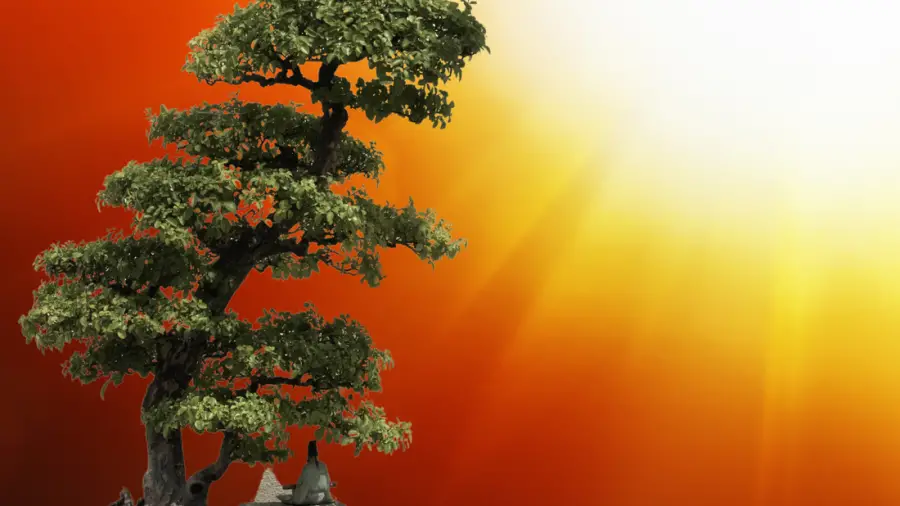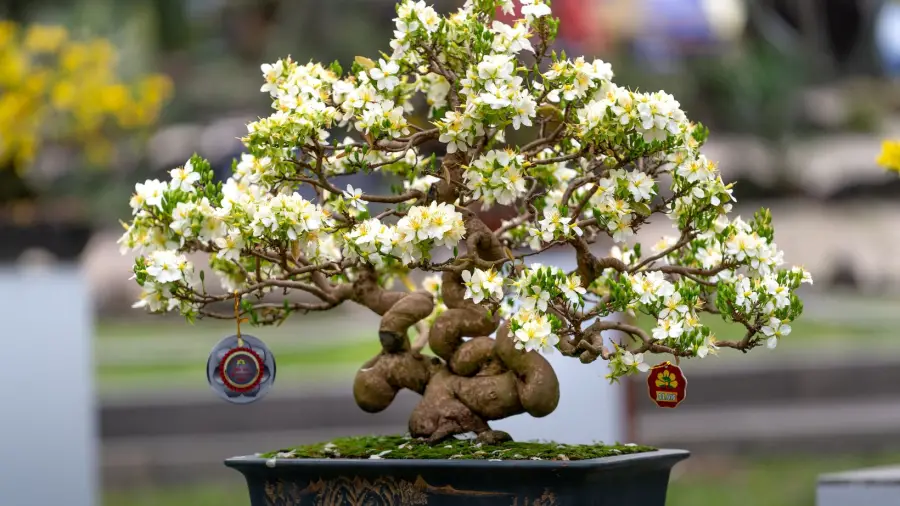During hot weather, bonsai require vigilant watering and shading. Protect the roots by keeping pots out of direct sunlight.
Bonsai enthusiasts know that the scorching heat of summer can pose a serious challenge to the health of their miniature trees. As temperatures soar, careful attention to watering schedules becomes crucial. A bonsai’s limited root system, confined within a small container, can lead to quick drying of the soil and potential root damage if left unchecked.
Bonsai Care During Hot Weather: Providing shade during the hottest part of the day is equally vital to prevent leaf scorch and maintain the overall well-being of the plant. It’s a delicate balance of ensuring ample sunlight for growth while protecting the bonsai from the intense heat that could cause stress or even be fatal. Crafty tactics like using light-colored reflective materials to deflect harsh rays or employing a fine mist to cool the foliage become part of a meticulous care routine designed to guide these miniature trees safely through the heatwaves.

Credit: www.reddit.com
The Scorching Challenge: Bonsai In The Summer Heat
Bonsai trees feel the summer heat just like us. They show heat stress symptoms you can spot. Watch for leaf wilting, dry soil, and sunburned leaves. These are signs your little tree needs help.
Ideal temperatures for bonsai range from 64°F to 75°F (18°C to 24°C). It’s hot outside, and your bonsai might suffer if the mercury rises too much. Keep them cool and avoid direct, harsh sunlight.

Credit: bonsai-en.shop
Water Wisdom: Quenching Bonsai’s Thirst
Quenching your bonsai’s thirst starts early in the day. Watering at dawn benefits plants. It allows water absorption before heat builds. The soil remains moist, roots stay hydrated.
As evening approaches, a second soak can prove pivotal. It cools the soil and prepares your bonsai for overnight recovery. It’s key to avoid midday watering, as evaporation rates are higher.
- Supple leaves and pliable branches indicate good hydration.
- Dry, brittle foliage signals a need for water.
- A balanced, damp soil consistency is your goal.
Shade Strategies: Protecting Bonsai From Harsh Sun
Creating a shelter for your bonsai is essential in hot weather. DIY shade solutions can be straightforward and effective. Positioning a lattice above your bonsai can provide dappled light. Dappled light mimics natural sunlight patterns beneath trees, which is gentle on the bonsai. Use a cloth, bamboo mat, or a shade net to filter the sun’s intensity. Ensure the material is elevated above the tree’s highest point to allow air circulation. This setup reduces leaf scorch and soil overheating.
An alternative approach is to construct a canopy. A simple frame with a light-colored tarpaulin can deflect direct sunlight. Remember to adjust the shade throughout the day if needed. Your bonsai will thrive with this protection from the harsh summer heat.
Soil And Surface Care
Applying moss helps to prevent soil from drying out quickly. It’s like a sun hat for the soil. It keeps root temperatures down.
Mulching acts like a shield. It holds in moisture. Think of mulch like a drink for your plant on a summer day.
| Mulch Type | Benefits |
|---|---|
| Organic compost | Improves soil over time |
| Bark chips | Slows evaporation |
| Gravel | Reflects sun away |
Remember, care for these little trees is easy with the right steps. Keep soil cool, and your bonsai will thank you. Use moss and mulch to help!
Pot Positioning And Heat Barriers
Bonsai trees love cool shades. Direct sunlight can harm them in hot weather. Use a heat barrier to protect them.
Pot materials matter too. Some keep roots cooler than others. For example, ceramic pots are better than metal ones.
| Pot Material | Heat Retention |
|---|---|
| Ceramic | Low |
| Plastic | Medium |
| Metal | High |
Fertilizer And Feeding During Heatwaves
Bonsai trees need special care during hot spells. The right nutrients are vital for tree health. Nitrogen, Phosphorous, and Potassium are key. Use products marked as “slow-release” when temperatures soar.
Alter your fertilization schedule based on heat intensity. Trees may need feeding less often during extreme heat. If a heatwave is brief, you might skip a feed. Ensure any feeding does not stress your bonsai.
| Element | Function | Heatwave Adjustment |
|---|---|---|
| Nitrogen | Growth | Reduce |
| Phosphorous | Root development | Maintain |
| Potassium | Overall health | Keep consistent |
Misting: Bonsai’s Leafy Relief
Proper misting is crucial for bonsai health in hot weather. It keeps leaves refreshed and reduces heat stress. But there’s a fine line to follow. You must mist in a way that avoids excess moisture, which can foster fungal diseases.
To mist effectively, use a fine sprayer. Aim for early morning or late afternoon. These times ensure quick evaporation, reducing fungal risk. Do not mist in the dark. The lack of sunlight keeps leaves wet too long, inviting fungus.
| Time of Day | Misting Benefits | Risks If Done Improperly |
|---|---|---|
| Early Morning | Better evaporation, less stress on plants | Lower risk of fungi due to sun presence |
| Late Afternoon | Cool down plants after a hot day | Can lead to fungal issues if not evaporated |
Spraying leaves should be gentle and even. Regular checking of the bonsai soil for proper hydration complements leaf misting. Always observe your bonsai for signs of stress or disease. A careful misting routine can mean the difference between a thriving bonsai and one that struggles in the heat.
Emergency Measures For Extreme Temperatures
Urgent Cooling Techniques include strategically moving bonsai to shaded areas. Use fine-spray misting to cool the foliage. Place cooling tiles or frozen water bottles around the pot. This helps lower soil temperature. A light-colored, reflective surface under the pots reflects heat away.
For Heat-Damaged Bonsai, provide ample shade and water early in the morning. Wrap pots in moist cloth and monitor closely.
Summer Season Repotting: Do’s And Don’ts
Repotting bonsai during summer poses risks. High temperatures stress plants, especially when roots get exposed. Aim to repot early morning or late afternoon when it’s cooler. Shade the pot post-repotting to prevent root burn. Never repot during peak temperatures; it could harm your bonsai.
| Do’s | Don’ts |
|---|---|
| Water the bonsai before repotting | Avoid direct sunlight post-repotting |
| Repot in the cooler hours | Don’t stress the roots in heat |
Preventing Pests And Diseases In The Heat
Summer heat invites various pests like spider mites and aphids to your bonsai. It’s crucial to stay vigilant.
Use organic sprays, like neem oil, to deter pests. Safe for kids and pets, these are friendly options. Chemical pesticides are another line of defense. They act fast. Always follow the manufacturers’ instructions.
| Organic Tactics | Chemical Tactics |
|---|---|
| Neem oil application | Synthetic insecticides |
| Introducing beneficial insects | Systemic pesticides |
| Garlic or chili pepper sprays | Contact pesticides |
| Regular inspections | Targeted insect baits |
Outdoor Bonsai: Determining The Right Exposure
Summer presents unique challenges for outdoor bonsai trees. The key to success lies in managing sunlight exposure. As the season changes, your bonsai needs careful attention to avoid stress from intense heat. Shade is crucial, especially during peak sun hours.
To create a microclimate, consider positioning bonsai under larger plants or using a shade cloth. This simulates a natural canopy, protecting your delicate trees. Always keep the soil moist, not wet, to provide necessary hydration without overwatering. Water early in the morning for the best results.

Credit: www.reddit.com
Bonsai Aftercare: Post-heatwave Recovery
The key to recovering a bonsai after a heatwave lies in accurate health assessment. Inspect the tree carefully, checking for signs of leaf scorch or wilted branches. The soil should feel damp but not satiated with water. Yellow or brown leaves indicate stress and require immediate attention.
Begin rehydrating your bonsai by watering thoroughly yet gently to avoid root damage. Shade is crucial for recuperation, shielding the bonsai from harsh sun. Mulching can help to retain soil moisture. Consider a balanced fertilization to replenish lost nutrients, but only once the plant shows recovery signs.
Regular monitoring of the bonsai’s condition allows timely interventions and ensures successful recovery. A recovery plan tailored to your bonsai’s specific needs will help it thrive after extreme heat exposure.
Frequently Asked Questions For Bonsai Care During Hot Weather
How Hot Is Too Hot For Bonsai?
Bonsai trees are at risk of heat damage at temperatures above 90°F (32°C). Always ensure they receive sufficient water and shade.
How Do You Take Care Of A Bonsai Tree In The Summer?
Water your bonsai thoroughly and regularly. Shield the pot from direct sunlight to protect roots. Provide shade during peak sun hours. Mist the leaves to cool them but avoid midday sun. Use white sphagnum moss to cover soil and retain moisture.
How Do I Keep My Bonsai Cool?
Place your bonsai in shaded areas during peak sun hours. Use a fine spray to mist the foliage. Water adequately, especially during early mornings or evenings. Shield the pot from direct sunlight. Add a layer of protective moss to the soil surface.
Can You Leave Bonsai Outside In Summer?
Yes, you can leave bonsai outside in summer, but ensure they are well-watered, protected from extreme heat, and shaded during intense sun exposure.
Conclusion
As the mercury soars, remember your bonsai’s resilience relies on mindful care. From strategic watering to smart positioning, safeguarding these miniature marvels in scorching climates is doable with the right techniques. Embrace these summer survival tips and watch your bonsai not just endure, but thrive.
Stay vigilant, stay informed, and ensure your little tree’s grandeur lasts through the hottest days.



